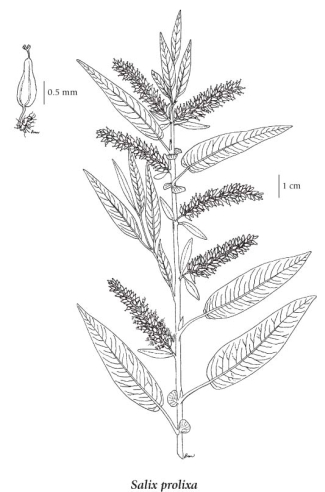Salix prolixa Andersson
Mackenzie willow (MacKenzie's willow)
Salicaceae (Willow family)
Introduction to Vascular Plants
Mackenzie willow (MacKenzie's willow)
Salicaceae (Willow family)
Introduction to Vascular Plants
Species Information
General:
Dioecious shrubs, 1-5 m tall, not colonial; branches erect, flexible at base; twigs yellow- to red-brown, smooth or moderately hairy.
Leaves:
Alternate, simple, lance- or egg-shaped to narrowly oblong, 5-15 cm long, 1-5.3 cm wide, lower surface glaucous, smooth, upper surface dull, smooth or sparsely long-hairy on midrib, margins toothed, bases rounded or heart-shaped, tips tapered; leaf stalks without glandular dots at top; stipules leaflike.
Flowers:
Unisexual, lacking sepals and petals, borne in catkins which flower as leaves emerge, the catkins stout, on leafy twigs; floral bracts dark, smooth or hairy, hairs wavy; stamens 2; ovaries 1, smooth; styles 0.3-1 mm long.
Fruits:
Capsules which split open to release the seeds, each of which is surrounded by a tuft of hairs; stalks 1.3-4.2 mm long.
Notes:
The twigs of this species are usually smooth, but plants with spreading-hairy twigs, the basis of the name S. rigida var. macrogemma, are common on Vancouver Island and are scattered elsewhere. Plants with hairy twigs are sometimes difficult to distinguish from S. barclayi.
Illustration

If more than one illustration is available for a species (e.g., separate illustrations were provided for two subspecies) then links to the separate images will be provided below. Note that individual subspecies or varietal illustrations are not always available.
Illustration Source: The Illustrated Flora of British Columbia
USDA Species Characteristics
Flower Colour:
White
Blooming Period:
Early Spring
Fruit/Seed characteristics:
Colour: Yellow
Present over the Summer
Source: The USDA
Ecology
Ecological Framework for Salix prolixa
The table below shows the species-specific information calculated from
original data (BEC database) provided by the BC Ministry of Forests and Range.
(Updated August, 2013)
The table below shows the species-specific information calculated from
original data (BEC database) provided by the BC Ministry of Forests and Range.
(Updated August, 2013)
| Site Information |
Value / Class |
||
|
Avg |
Min |
Max |
|
| Elevation
(metres) |
937 | 50 | 1825 |
| Slope
Gradient (%) |
2 | 0 | 24 |
|
Aspect (degrees) |
322 | 0 | 360 |
| Soil
Moisture Regime (SMR) [0 - very xeric; 4 - mesic; 8 - hydric] |
6 | 2 | 8 |
| Modal
Nutrient Regime
Class |
D | ||
| #
of field plots species was recorded in: |
161 | ||
| Modal
BEC Zone Class |
SBS | ||
|
All BEC Zones (# of stations/zone) species was recorded in |
BG(6), BWBS(20), CWH(1), ESSF(7), ICH(15), IDF(34), MS(12), PP(3), SBPS(7), SBS(49), SWB(3) | ||
|
Source:
Klinkenberg 2013
|
|||
Habitat and Range
Moist forest openings, sand and gravel riverbars in the lowland, steppe and montane zones; common throughout BC; N to SE AK, S YT and NT, E to AB and S to WY, UT, NV and CA.Status Information
Synonyms
Synonyms and Alternate Names:
Salix cordata var. mackenzieana Hook.
Salix eriocephala subsp. mackenzieana (Hook.) Dorn
Salix eriocephala subsp. prolixa
Salix eriocephala var. mackenzieana (Hook.) Dorn
Salix mackenzieana (Hook.) Barratt ex Andersson
Salix mackenzieana var. macrogemma Ball
Salix rigida subsp. mackenzieana (Hook.) E. Murr.
Salix rigida var. mackenzieana (Hook.) Cronquist
Salix rigida var. macrogemma (C.R. Ball) Cronquist